The drainage basin as an open system
The hydrological cycle
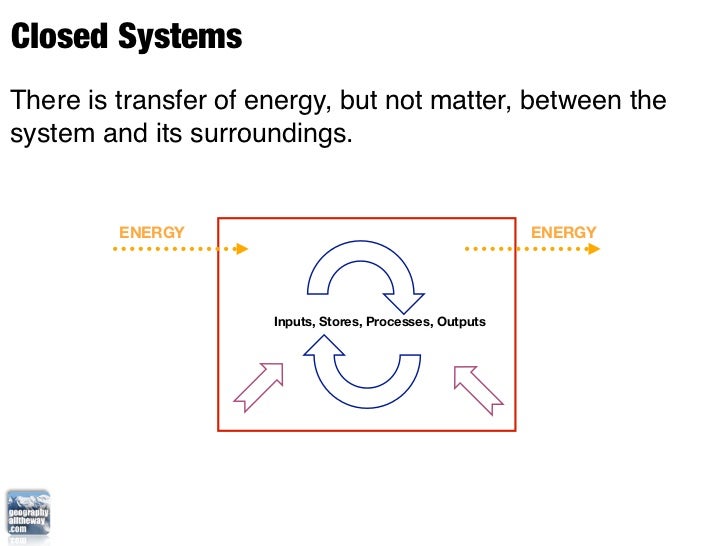
Source: http://www.geographyalltheway.com/in/ib-freshwater/hydro-cycle.htm
The hydrological cycle is said to be a closed system because water can not be added or lost. Although water can not be added or lost it can be found in different states and in different locations. Despite the planet being covered in water, the vast majority is sea water (97.5%). Of the remaining 2.5% the majority is held in glaciers and ice sheets. Only a very small amount of the world's water is easily accessible in rivers and lakes (0.00069%).
Source: http://greenfieldgeography.wikispaces.com/The+hydrological+cycle
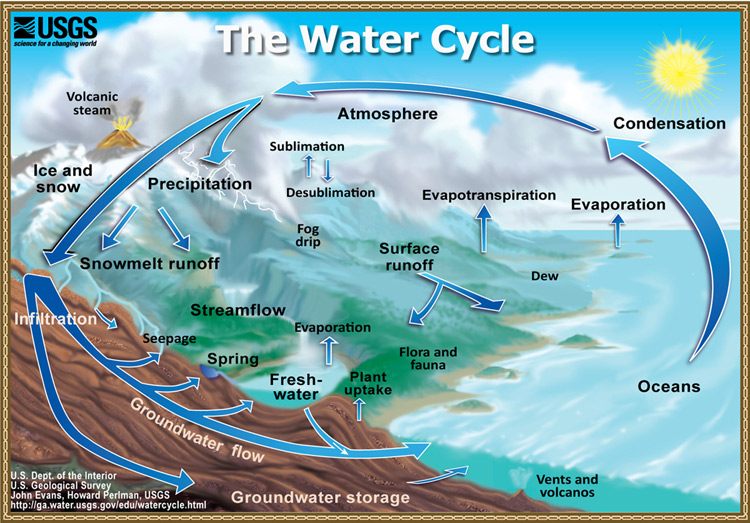
Source: https://water.usgs.gov/edu/graphics/watercyclesummary.jpg
The drainage basin

Source: Source: http://www.bbc.co.uk/schools/gcsebitesize/geography/water_rivers/background_rivers_rev2.shtml

The drainage basin can be considered a section of the closed hydrological cycle as well as an open system in itself with its inputs processes and outputs.

http://blackpoolsixthasgeography.pbworks.com/w/page/22997473/The%20drainage%20basin%20hydrological%20cycle%20%E2%80%93%20the%20water%20balance

Source: https://prezi.com/9cvqkugz43am/elements-of-the-drainage-basin-systems/
Feedback Loops: A system is always trying to maintain a balance (equilibrium). Feedback loops explain when a system (drainage basin) loses and attempts to regain its balance. Positive feedback causes an instability by changing inputs (increase in precipitation). Negative feedback attempts to regain the equilibrium by reducing inputs or possibly increasing outputs. Humans can alter feedback loops by changing the amount of water released from dams, changing the amount of water used or even increasing run-off through deforestation.
Source: http://greenfieldgeography.wikispaces.com/Drainage+basins
Negative and positive feedback systems keep a system in dynamic equilibrium. A negative feedback decreases the amount of change by reducing some of the inputs, returning the system to stability. Positive feedback is less common. It increases the amount of change. This leads to an imbalance.
Feedback Loop
Source: http://www.geographyalltheway.com/in/ib-freshwater/drainage-basins-tasks.htm
Discharge
In hydrology, discharge is the volume rate of water flow (velocity), which is transported through a given cross-sectional area.
Discharge is normally measured in cumecs (cubic metres a second).
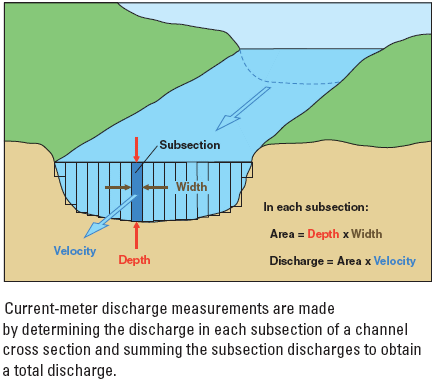
Source: http://www.thegeographeronline.net/freshwater---issues-and-conflicts.html
Bed: The bottom of the river channel
Bank: The sides of the river channel.
Channel: The confines of the river, encompassing the bed and two banks.
Wetted Perimeter: The total length of the bed and the banks in contact with the river.
Cross-sectional area: The width of the river multiplied by the depth of the river. Because the depth of the river will vary across its width, an average depth reading is normally taken. The cross sectional area is normally given in m2.
Velocity: This is the speed that the water in a river is travelling at. The unit of measurement is normally metres a second (m/s). River velocity can be measured using a flowmeter (pictured right), or more commonly by timing a floating object over a set distance (pictured left). Velocity is then calculated by dividing the time (seconds) by the distance (metres).
Discharge: This is the amount of water in a river at a given point. Discharge is normally measured in cumecs (cubic metres a second). It is calculated by multiplying the cross-sectional area by the velocity.
As you move from the source to the mouth, both the discharge and velocity of a river increases.
Source: http://greenfieldgeography.wikispaces.com/Discharge

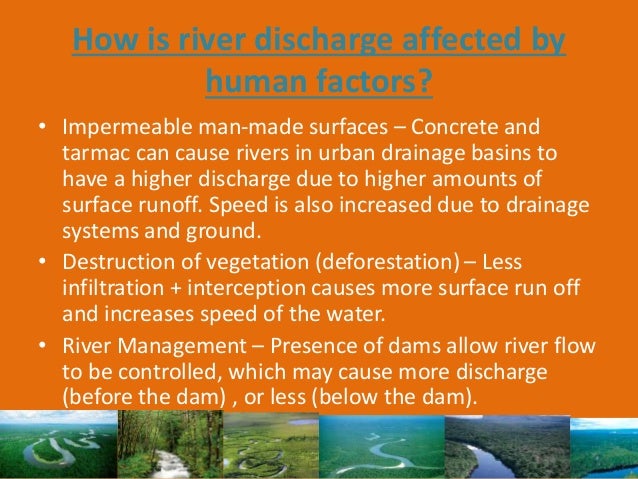
Source: http://www.thegeographeronline.net/freshwater---issues-and-conflicts.html
The profile of a river and the Bradshaw model
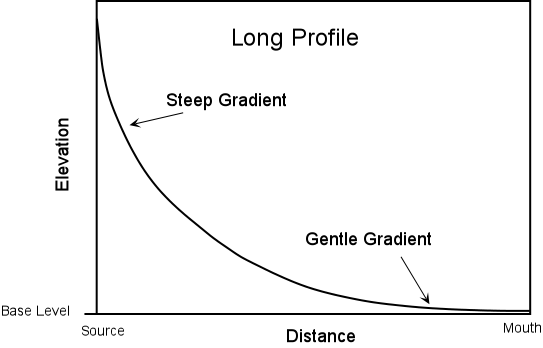
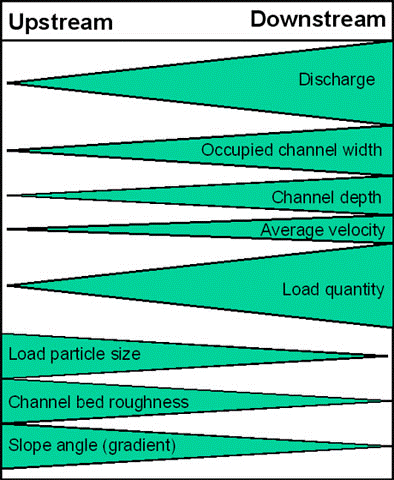
Source: http://greenfieldgeography.wikispaces.com/Discharge
River processes

Source: http://www.indiana.edu/~g103/G103lectures/rivers/wk6.html
Erosion

Source: http://greenfieldgeography.wikispaces.com/IGCSE+Rivers+and+GCSE+Rivers
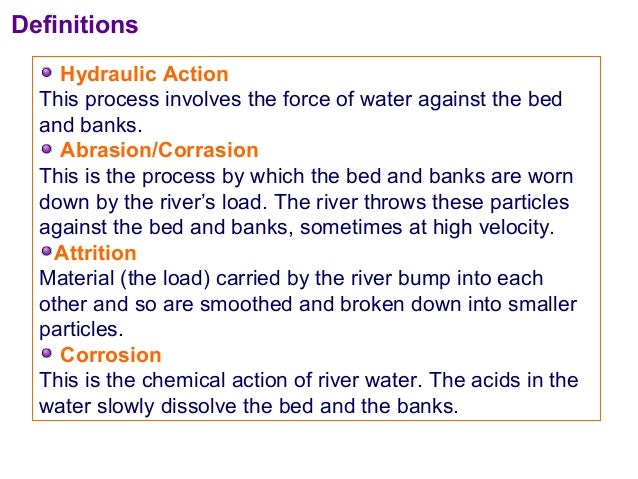
Source: http://www.slideshare.net/hfonfe/yr10-riverslesson-2river-processes
* Solution = Corrosion
Transport
Flotation: Leaves and twigs carried on the surface of the river.

Source: http://greenfieldgeography.wikispaces.com/IGCSE+Rivers+and+GCSE+Rivers
Deposition

Source: http://www.yorkshiredalesriverstrust.com/river-processes-a-level-resources/
River landforms
Meander and oxbow lake

Source: http://www.bbc.co.uk/bitesize/standard/geography/rivers/river_forming/revision/2/
Rapids and waterfalls

Source: http://www.coolgeography.co.uk/A-level/AQA/Year%2012/Rivers_Floods/Landforms/Landforms.htm

Source: http://www.coolgeography.co.uk/GCSE/AQA/Water%20on%20the%20Land/Waterfalls/Waterfall_Formation.jpg
Floodplain

Source:http://www.coolgeography.co.uk/GCSE/AQA/Water%20on%20the%20Land/Meanders/Floodplains%20and%20Levees.jpg
Levees

Source: http://www.geography.learnontheinternet.co.uk/topics/river_deposition.html
Delta

Source: http://www.coolgeography.co.uk/A-level/AQA/Year%2012/Rivers_Floods/Landforms/Delta%20Formation.jpg

No comments:
Post a Comment